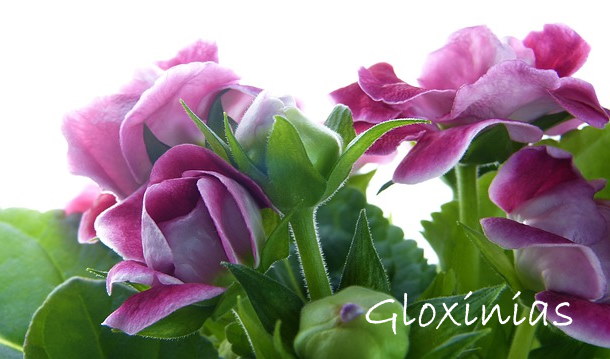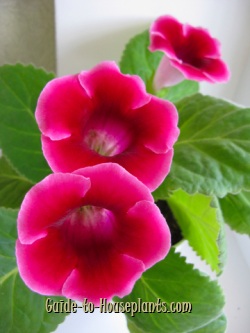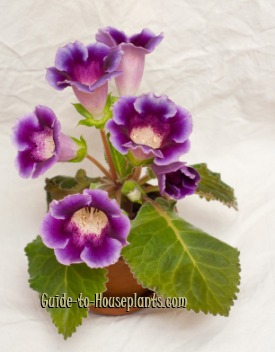Growing Florist Gloxinia Plant Indoors
Botanical Name: Sinningia speciosa hybrids
Big, ruffled, bell-shaped blooms of florist gloxinia are available in a rich range of colors -- red, burgundy, pink, white, violet and purple. Some varieties have blooms edged in white, or have a contrasting spotted throat color.
 Soft, velvety Gloxinia flowers put on a gorgeous show, with a bloom time lasting several weeks.
Soft, velvety Gloxinia flowers put on a gorgeous show, with a bloom time lasting several weeks.Velvety flowers are carried on slender stems above a rosette of large, oval, hairy leaves with scalloped edges.
Originally, these showy gloxinia flowers were only grown from tuberous roots that went dormant in the winter. The tubers were then replanted for another seasonal show of flowers. Today, many gloxinias sold in florist shops were bred to grow from seed. These seed-grown hybrids produce better blooms because they don't devote energy to their root systems. However, their ability to come back after a dormant period is likely to be poor. They're treated as annuals and tossed out after one blooming season.
Each flower lasts about a week, with continuous blooming time lasting several weeks. Pinching off spent flowers will prolong the blooming season.

After-Flowering Care
Overwinter tuber-grown gloxinias. Plants grown from tubers can be stored in a cool, dry place for the winter and made to bloom the following year. After flowering, water lightly until the leaves die down. Then, allow the soil to dry out and overwinter the tuber in its pot. Keep it cool (about 50°F/10°C) during this dormancy.
Repot tubers in spring. To make the plant bloom again, pot the tuber hollow side up on the surface of fresh soil. Moisten the soil every few weeks. When you see new growth, place the pot in bright, indirect light and begin watering and fertilizing regularly.
Buying tip: Choose a plant with buds that are just beginning to open. You'll enjoy a succession of blossoms that will last for several weeks. Seed-raised varieties include 'Glory', a compact plant, and 'Brocade' with double flowers.
Gloxinia Problems, Solutions and Answers
White halos on leaves are caused by cold water. Always use room-temperature water for watering houseplants.
Dropped buds? Dry air and hot or cold drafts may cause flower buds to drop off before they open. Keep your plants away from entry ways and heat/AC vents. Gloxinias are native to South American rainforests, where the relative humidity stays well above 70%. Short of turning your home into a misty rainforest, there are a few things you can do to raise the humidity for your plant.
Something bugging your gloxinia? Spider mites are attracted to warm, dry conditions and may invade houseplants. Look for webbing between stems and foliage or dry-looking, yellow-speckled leaves as signs of an infestation. If your plant is seriously infested, get rid of it -- treatments with an insecticidal soap typically destroys the flowers. Wet, peaty potting mixes may attract fungus gnats -- these are easier to get rid of. Look for tiny, black insects crawling on the surface of the potting medium.
Yellow leaves may be caused by over-watering or too much direct sunlight. Older leaves will turn yellow then brown as the plant enters dormancy, this is normal.
Are Gloxinias poisonous? No. Sinningia hybrids are in the Gesneriaceae family, along with African violets and are non-toxic. You can keep them indoors with peace of mind, knowing they are safe around children, cats and dogs.
Gloxinia Growing Tips

Origin: Brazil
Height: 8 in (20 cm)
Light: Bright light; no direct sun.
Water: Keep soil evenly moist. Provide good drainage or the roots may rot. Avoid getting the velvety leaves of this plant wet. Water will cause brown spots on the leaves and they won't come off. If the leaves need to be cleaned, brush them gently with a soft, dry brush, such as a small paintbrush. Remember to always use room-temperature water when watering your indoor plants.
Humidity: This Brazilian rain forest native likes humid air. Try to maintain at least 50% relative humidity around your gloxinias. (Your other tropicals will love this, too!) Set plant on a tray of wet pebbles or use a cool-mist room humidifier. Do not mist because misting may cause spots or fungus the flowers and leaves.
Temperature: Average room temperatures 65-75°F/18-24°C
Soil: African violet potting mix has a light peaty mix with added perlite that is ideal for this flowering houseplant.
Fertilizer: Feed every 2 weeks while the plant is growing and blooming with a high-phosphorus water-soluble fertilizer. Don't use a balanced fertilizer, because too much nitrogen can cause the leaves to become twisted or curled.
Propagation: Seeds; leaf cuttings; division of tubers.


